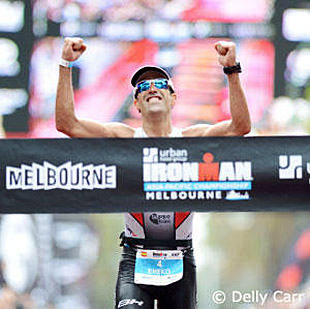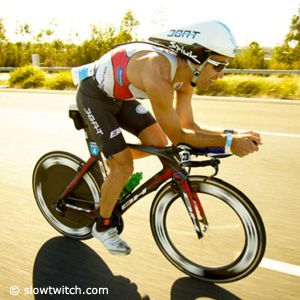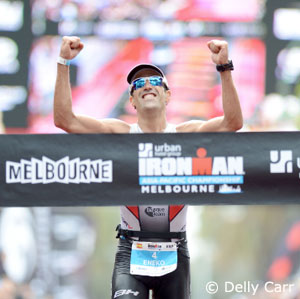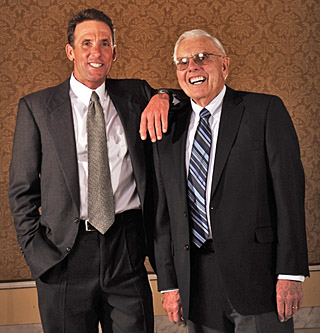Dave Scott on coaching Eneko
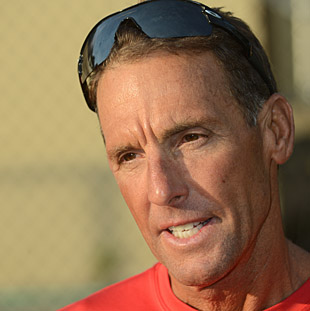
Since he started working with Dave Scott as his primary coach late last year, the already stellar career of Eneko Llanos has taken a step up. With impressive wins against great fields at Melbourne and Frankfurt, Llanos is going into Ironman Hawaii with renewed confidence. As the best Ironman triathlete of the first half of 2013 he can realistically say he has a real chance to improve on his runner-up finish of 2008.
While Llanos is happy to follow Scott’s regimen, he begs off trying to explain the details. “Regarding my training, it is more intense now and much more specific,” he says. “Dave's workouts are very specific and many times I have to write them down on a paper because I can’t memorize everything I have to do. But it makes the training very entertaining.”
The Man, on the other hand, provides some of the details of the workouts that have helped Eneko Llanos to the best ever start in his 17-year career.
Slowtwitch: Can you explain what Eneko has done differently in training this year?
Dave Scott: I don’t know precisely what he has done differently because I don't know his exact program from previous years. But I always look at what they have done in the past to some degree. So the last thing I want to do is to come in and revamp the entire program and change what is already working. That said, I felt like Eneko was missing a few areas of efficiency in all three sports – and collectively. So we decided to work on those things.
ST: Such as?
Dave: I thought he had some glaring weaknesses. He didn’t have a top end on the bike at all. His VO2 output on the bike was very, very low. His work output at threshold was also too low.
For those who may be hazy on what threshold pace and sub-threshold pace is, famed running coach Jack Daniels offers this definition: “The proper pace for threshold-pace running is about 83 to 88 percent of VO2 Max, or 88 to 92 percent of maximum heart rate. You can establish your proper pace for threshold running fairly closely by running at a velocity that produces an elevated yet steady state of blood lactate accumulation. This pace is a little faster than a pace that you could maintain for two or more hours (marathon pace for most people) but slower than the pace you could maintain for 30 minutes (10K race pace for better runners).”
Dave: I thought if Eneko could elevate his threshold power and VO2 power, that would help his economy at sub-threshold pace – which reflected in his Ironman and half Ironman output and times. He was not very economical at sub threshold run pace and that revealed itself as a weakness at the end of Ironman marathons. So that’s what we tried to work on.
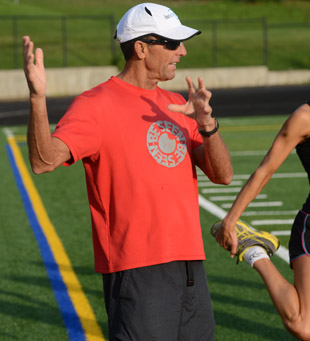
ST: What specifically did you have him do in training to achieve those results?
Dave: Working on threshold on the bike, I tried to upgrade his 60-90 minute output at a very, very hard effort. I also took a look at what he can do for an Olympic distance race or slightly longer – say a 40k to 55k bike segment. I wanted to find out the maximal speed and power he can sustain.
ST: How did you go about that?
Dave: I had him do sets broken up into Schroder (shorter) 3 minute segments. We started, for example, at 8 times 3 minutes. Eventually we went longer — 3 times 25 minutes. We also changed his gearing load to vary the muscle activation and not let him always ride in his choice TT gear. The purpose was to make him more efficient at lower gearing with faster rpms. When we began, he had a big disparity between his time trial gear and his lower gears. His rpms were a little too low because he did all his training in his choice gear regardless of the workload in any workout, ranging from aerobic to sub threshold. So I tried to tweak his gear load so that he experienced muscle tension changes between low gear and big gear.
ST: What would that do for him?
Dave: Ultimately in a race he would have a bigger arsenal to pick from. There are subtle changes in races which would allow him to accelerate with more ease – and allow him to climb at a high workload and recover. He suffered at Ironman Melbourne, but he was able to follow the lead of Craig Alexander, had a good bike split, and then ran well.
ST: Was his bike split at Frankfurt different from his performance at Melbourne?
Dave: He had a much stronger, steadier bike in Frankfurt, which was a good step forward from where he had been — even though on paper his bike splits at Melbourne and Frankfurt looked the same [4:28:50 at Melbourne, 4:25:32 at Frankfurt] . I think he had a big enough lead after the bike at Melbourne to maintain and even split or negative split the marathon.
ST: What did the splits at Frankfurt show?
Dave: One thing I do not like to see is a drop off in the last 12 to 15 kilometers of the run. He had a little falloff but he had a big buffer. When he sensed that he was within reach of a sub 8 hours he ran a smashing fast last kilometer– 3:35. At Melbourne he ran a good strategic race and ran a solid 2nd half. But his run pace right after the bike was still slow.

ST: How good a runner is he at shorter distances?
Dave: I think he is a gifted runner. He ran 1:08:41 off the bike in Mallorca, and that was amazingly fast.
ST: Was that the fastest ever Ironman 70.3 run – or close to it?
Dave: I think Michael Raelert ran 1:08 in one race. I noticed a few 1:09s. But Eneko at Mallorca was very quick.
ST: Eneko has been superb throughout his long course career. Why is he going so well now?
Dave: He has adapted well to the changes that we've collectively implemented. I think Eneko spent 10 years with his last coach [Iñigo Mujika] and he certainly had some marvelous races and obviously benefited from some great coaching. But his results the last few years have been up and down. I suspect he felt he needed different set of eyes and a different slant on his program.
ST: How did you approach tinkering with a great triathlete?
Dave: I didn’t feel I had the answers right away. We had a long conversation before we started. I got a lot of information on his past – what works, what he likes to do, his training history and felt I understood it reasonably well. I did not dissect his old workouts. But our conversations gave me a good head start on the approach we should take.
ST: How did your collaboration start?
Dave: I said ‘We will both be learning. Let's try this first cycle for 6 weeks then go over it and see how you are doing. If you progress and think the first 6 weeks were good, we can continue.’
ST: What was the thing you worked on first?
Dave: We did a lot of swing pace.
ST: What is swing pace?
Dave: I had Eneko vary his pace a little bit. On one session of a bike-run segment and another standalone run segment, I would have him change the tempo where he would start at a slightly faster than threshold pace, and make a swing of anywhere from 25 to 40 seconds between kilometers. For example, he might run one kilometer at 3:45 and the next kilometer at 3:20 pace, then 500 meters at 3:00 pace and recycle that.
ST: Is swing pace a different approach than many triathletes take?
Dave: A lot of people want to run at X pace in the marathon off the bike, so they try to train at that one pace. The thinking is, if you want to run a 2:37 Ironman marathon, you have to run the whole distance at 3:45 per kilometer. I believe an elite Ironman triathlete must train the body to conserve muscle glycogen by subjecting the fast twitch muscle fibers through adaptation in training. The fast twitch 2a muscle fibers have a much higher contractile force and at the same time they fatigue and burn glycogen at a higher rate. The nuances of a race are quite often dictated by the competition. In many races, you do not ride or run at a programmed steady state. I think it is important to have fluctuations around the optimal pace in a training program, so you can ultimately learn how to pace better in a race.
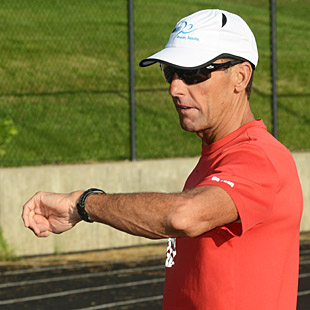
ST: What happens if you do not vary the pace in training?
Dave: Typically the athlete will show signs of fatigue at the end of the bike and the run. Ultimately, the end of Ironman runs are quite slow if you do not change the tempo of bike and run segments in training.
ST: How is Eneko recovering after those tough swing pace workouts?
Dave: Eneko is very resilient and recovers well. In the days before his races, he has to have the lighter days built into his cycles, so his training is not all slam and go smash himself every workout because that approach is apt to lead to diminishing returns.
ST: How hard is it to find the optimum level of overload for each athlete during a long season?
Dave: All athletes are individuals on that issue and that is something I am very cognizant of. Eneko raced a lot early this year. He did a few races which were a kind of a requirement of his sponsors. I was not too keen that he would stack up his races so closely. But after Frankfurt, he will have more down time. Fortunately, he got married after that race and that allowed more downtime as well. So this is a nice block where he’s been able to train pretty lightly. He needs more recovery now that his fitness level is higher than after Melbourne. So this will be a good buildup for Hawaii and he can take a longer, more gradual buildup.
ST: What does it mean that he has had the best first half of the season?
Dave: Obviously there is not a male pro alive who does not know Eneko had the best first half year. But Eneko would trade his great results of the first half if he can have the race of his life at Hawaii.
ST: What is the most important thing about his Kona preparation?
Dave: We both need to be careful and pragmatic regarding his preparation for Hawaii. Everyone knows I know talk to Craig [Alexander] and a number of top athletes and they all agree the first priority is to stay injury free. If Eneko feels pretty whole in October, this could be his day. And that is huge. Eneko’s swim-bike-run training so far has had a big overload component and he has a strength program totally different from the past. Obviously I am a big advocate that injury preventative measures are paramount for the last half of the year
ST: How satisfying is it to work with such great athletes?
Dave: I consult regularly with a small group of athletes. I can’t manage any more. I advise a number of pros but my priority is Eneko, Rachel Joyce, Julie Dibens, Craig Alexander and my son Drew. I also have a small handful of others including some amateurs.
ST: What is the attraction of coaching athletes?
Dave: It’s a puzzle. It is not puzzling. But it is a puzzle to put all the pieces together correctly.
ST: You have a great base of physiological knowledge. But how important is the emotional and psychological component of coaching?
Dave: I like to try to figure out every one’s emotional temperament. It is a huge part to make sure that things psychologically and emotionally flow along well. Athletes are not just robots. They are all dear people who are a genuine joy to work with. I frankly think and worry about them all the time and try to be as diligent as I can with them. I don’t say I am a guiding light. But I want to do everything I can to help them reach their potential.


